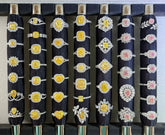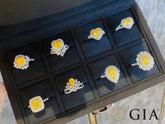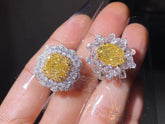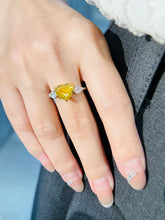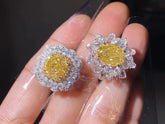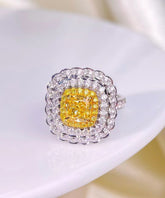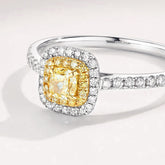Laboratory-grown diamonds: 5 misconceptions and truths
With the rise of laboratory-grown diamonds in the market, there has been a wealth of new information, opinions, and misconceptions. Some people embrace laboratory-grown diamonds, while others endlessly criticize them. Today, let's discuss some misconceptions and truths about laboratory-grown diamonds:

Misconception 1: Laboratory-grown diamonds are not real diamonds.
Fact: Laboratory-grown diamonds are indeed real diamonds. The chemical composition of a lab-grown diamond is crystallized carbon, just like a naturally mined diamond. In other words, lab-grown diamonds are not only visually identical but also chemically identical to natural diamonds, with the same luster, hardness, durability, and beauty—along with the same chemical composition. The only difference is that lab-grown diamonds are grown in a laboratory, while natural diamonds are mined from the Earth. In fact, the Federal Trade Commission (FTC) in the United States is very convinced of the quality of lab-grown diamonds, so much so that they have even removed the word 'natural' from the definition of 'diamond,' considering lab-grown diamonds to be real diamonds just like natural ones.

Misconception 2: Are laboratory-grown diamonds durable?
Fact: Laboratory-grown diamonds are also durable. Since lab-created diamonds are the same mineral as natural diamonds, they are also classified as one of the hardest substances in the world. Whether a diamond is born in a lab or on the Earth doesn't matter. They both have a hardness of 10/10, which means the only thing that can scratch them is another diamond.
Do lab-grown diamonds become cloudy?
Fact: Lab-grown diamonds do not become cloudy. Unlike diamond simulants (stones that look like diamonds but are not), lab-grown diamonds have a hardness of 10/10, so they never become cloudy. Gemstones become cloudy when the surface of the gem is scratched or melted from normal wear and tear. This mainly happens with low-quality diamond simulants like cubic zirconia (CZ) or glass. However, lab-grown diamonds and natural diamonds are the purest form of carbon and are the hardest minerals on Earth. Since only another diamond can scratch a diamond, lab-grown diamonds do not become cloudy.

Misconception 3: Laboratory-grown diamonds are flawless.
Fact: Laboratory-grown diamonds can have a clarity grade of VS or higher! What is the best clarity for lab-grown diamonds? If you mean the rarest, the highest clarity we have seen is internally flawless—but that is extremely rare. VVS, VS, and SI clarities are more common, with VS and SI clarity making up the majority of lab-grown diamonds. However, 'best' is a relative term. So, if you mean the cleanest to the naked eye, then IF or VVS is the best clarity for lab-grown diamonds. If you mean the best value, then VS or SI1 clarity might be best for you.
What is crystal strain?
Fact: Laboratory-grown diamonds are not flawless; most have small inclusions, many of which are not visible to the naked eye, including crystal strain. Crystal strain is a type of 'streak' inclusion formed during the growth process of lab-grown diamonds. This often occurs when the diamond grows too quickly and can result in the diamond's optical system being slightly blurred. As you might expect, this is undesirable and can have a negative impact on the diamond's sparkle and beauty. Unfortunately, it is not listed on certification reports. So, when purchasing lab-grown diamonds, watch out for streak inclusions!
Can lab-grown diamonds have color?
Fact: Lab-grown diamonds can actually have more color options than natural diamonds—like blue, pink, and yellow. Since lab-grown diamonds have the same chemical composition as natural diamonds, they come in a variety of colors like natural gemstones. This means lab-grown diamonds can be colorless, near-colorless, pink, gray, blue, yellow, and more! Additionally, the unique methods used to create lab-grown diamonds (high pressure high temperature and chemical vapor deposition) can result in more trace elements entering the mix. As a result, some labs present rare pink, gray, or blue hues similar to natural diamonds.

Misconception 4: Why are laboratory-grown diamonds cheaper than natural diamonds?
Fact: Laboratory-grown diamonds are cheaper than natural diamonds because it costs less money and effort to manufacture diamonds than to mine natural diamonds. Natural diamonds are extremely rare—it takes deep-earth mining to unearth gem-quality diamonds. This requires a lot of manpower, machinery, time, and luck. On the other hand, laboratory-grown diamonds can be produced on demand in a controlled manner in a lab. This means less time, effort, and resources are needed. And these savings are passed on in the pricing process!

Misconception 5: Laboratory-grown diamonds are the same as Moissanite.
Fact: Laboratory-grown diamonds and Moissanite are different minerals with different optical properties. Lab-created diamonds have the same chemical composition as natural diamonds (pure crystalline carbon), while Moissanite is a completely different mineral from natural diamonds (silicon carbide). Therefore, even though laboratory-grown diamonds and Moissanite may have a similar appearance, they are different gemstones with different characteristics. For example, Moissanite is 'birefringent,' which means if you look very closely from the side, you can see its facets doubling (tiny double images throughout the stone). Moissanite also gives off more rainbow flashes than diamonds. Diamonds are singly refractive, meaning their sparkle is more uniform, and their white and rainbow flashes are consistent. Additionally, diamond has a hardness of 10/10, while Moissanite has a hardness of 9.25. Despite the seemingly small difference in hardness of 0.75, in reality, their hardness differs by tens of times. Diamond can easily scratch Moissanite, while Moissanite will not scratch diamond.
FAQs
-
Are laboratory-grown diamonds real?
-
Fact: Yes, they are chemically and visually identical to natural diamonds.
-
Are laboratory-grown diamonds durable?
-
Fact: Yes, they share the same hardness and durability as natural diamonds.
-
Do lab-grown diamonds become cloudy?
-
Fact: No, they maintain clarity due to their hardness.
-
Are laboratory-grown diamonds flawless?
-
Fact: No, they can have inclusions like crystal strain, affecting their appearance.
-
Can lab-grown diamonds have color?
-
Fact: Yes, they can come in various hues, including blue, pink, and yellow.
-
Why are laboratory-grown diamonds cheaper than natural diamonds?
-
Fact: They're less expensive to produce in labs compared to mining natural diamonds.
-
Are laboratory-grown diamonds the same as Moissanite?
-
Fact: No, they're different minerals with distinct optical properties and hardness.
———— / END / ————
